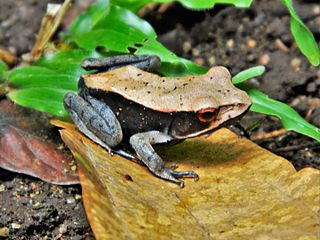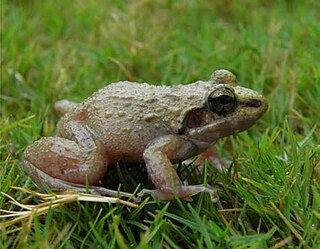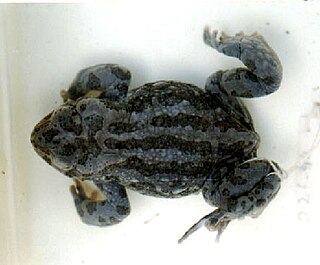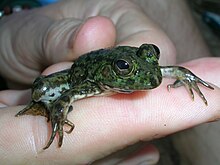
The bicolored frog or Malabar frog is a species of frog endemic to the Western Ghats of India. The tadpoles of the species are black and form dense and compact schools in slow moving streams in forested areas.

The fungoid frog or Malabar Hills frog is a colourful frog found on the forest floor and lower vegetation in the Western Ghats in south-western India from Bombay to Kerala. It is very similar to another species with which it overlaps partly in range, Hydrophylax bahuvistara which extends further into parts of central India. Although restricted in range within peninsular India, they are of least conservation concern. Their upper parts vary in colour from brownish-red to bright crimson.

The Indian burrowing frog is a species of frog found in South Asia.

Polypedates maculatus, the Indian tree frog, or Chunam tree frog, is a common species of tree frog found in South Asia. It was described by John Edward Gray in 1830.

Micrixalus fuscus is a species of small frog found in dense forested hill streams in the Western Ghats of India. M. herrei was formerly synonymized within this species.

Fejervarya limnocharis is a species of frog found in South East Asia and parts of Indochina. It is known under many common names, including Boie's wart frog, rice field frog, and Asian grass frog. Molecular studies of the species complex suggest that there may be multiple species involved.

Indirana leithii is a species of frog in the family Ranixalidae. It is endemic to the northern Western Ghats of India. As currently defined, its range is restricted to the states of Maharashtra and southern Gujarat; earlier records elsewhere refer to other species.

Euphlyctis hexadactylus, also known as the green pond frog, Indian green frog, and Indian five-fingered frog, is a common species of aquatic frog found in Pakistan, India, Bangladesh, and Sri Lanka. The nominal taxon likely represents a species complex.

Minervarya keralensis is a species of frog from India. Originally described by Albert Günther in 1876, its present-day specific epithet, keralensis, meaning "of Kerala", was introduced as replacement name by Alain Dubois in 1981.

Minervarya nepalensis is a small-sized frog native to northern and northeastern India, Bangladesh, and Nepal. It has recently been reported also from Bhutan. Having distinct and narrow middorsal line (MDL); indistinct skin fringe on outer side of 5th toe; relative finger length (RFL) is 2<1<4<3, 1st finger scarcely longer than 2nd; laterally dark and medially pale throat in males; body tubercles oblong, arranged in longitudinal folds; and snout jutting over jaw.
Walkerana leptodactyla is a species of frog endemic to the southern Western Ghats in Kerala and Tamil Nadu states of southern India. Precise reports are from Anaimalai hills, Palni hills, Meghamalai, Travancore hills and Agasthyamalai.

Duttaphrynus himalayanus, also known as the Himalaya toad, Himalayan toad, Himalayan broad-skulled toad, and Günther's high altitude toad, is a species of toad that is widely distributed throughout the Himalayan mountains. The Yunnanese populations are sometimes considered a separate species, Duttaphrynus cyphosus.

Theloderma asperum is a frog in the family Rhacophoridae. It is also known as the pied warty frog, hill garden bug-eyed frog, or somewhat informally, bird poop frog. The frog can be found in the northeastern India, Bangladesh, Bhutan, Burma, China, Thailand, Cambodia, and Vietnam as well as Sumatra in Indonesia. However, because of confusion with Theloderma albopunctatum and Theloderma baibungense, it is known with certainty from its type locality in Peninsular Malaysia.

Scotobleps is a monotypic frog genus in the family Arthroleptidae; its sole species is Scotobleps gabonicus, sometimes known as the Gaboon forest frog or Gabon forest frog. It is found in eastern Nigeria, western and southwestern Cameroon, Equatorial Guinea, western Gabon, western Republic of the Congo, and western Democratic Republic of the Congo. Its range could extend into the Cabinda Enclave of Angola.

Bufotes latastii, commonly known as the Baltistan toad, Ladakh toad or vertebral-banded toad, is a species of toad in the family Bufonidae. It is found in the West Himalayan region at altitudes of 780–3,200 m (2,560–10,500 ft) from northern Pakistan to Ladakh in India; although sometimes reported elsewhere, this is the result of misidentifications of other species. It is found in alpine forests, coniferous forests, grasslands, paddy fields, mountain desert and roadsides. It often lives near water, like lakes and ponds, in the riparian growth. It can be beneficial to humans as it feeds on insects and their larvae within areas of agriculture.

Euphlyctis ehrenbergii is a species of frog in the family Dicroglossidae. It is endemic to the southwestern Arabian Peninsula in Saudi Arabia and Yemen. It has been treated as a subspecies of Euphlyctis cyanophlyctis, but is now considered as a valid species. The specific name ehrenbergii honours Christian Gottfried Ehrenberg (1795–1876), a German natural scientist.

Nannophrys guentheri is an extinct species of frog in the family Dicroglossidae. It was endemic to Sri Lanka. The species was first identified in 1882 by George Boulenger and named after the German-born British zoologist Albert Günther. It is not known where in Sri Lanka the specimens were found.

Chirixalus doriae, commonly known as Doria's Asian treefrog, Doria's bush frog, and Doria's tree frog, is a species of frog in the family Rhacophoridae. It is found in southeastern Asia, from extreme northeastern India and adjacent Bangladesh to Myanmar, Thailand, Cambodia, Laos, Vietnam, and southern China.

Hylarana leptoglossa, commonly known as the long-tongued frog, is a species of true frog in the genus Hylarana. It is native to Bangladesh, northeastern India, Myanmar, and western Thailand. It is also known under the common names Cope's frog, Cope's Assam frog, palebrown small frog, and Assam forest frog. It has recently been reported also from Bhutan.























